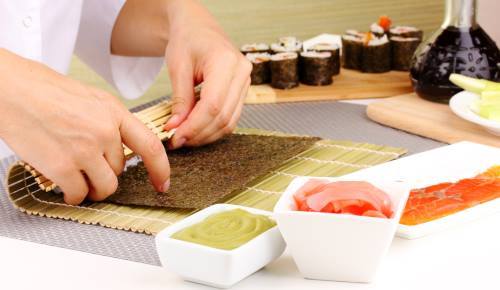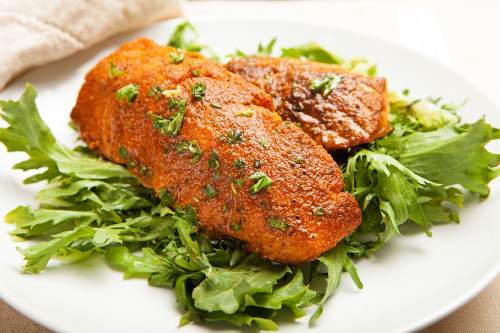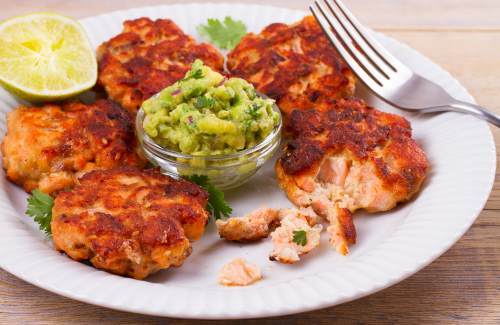Salmon is quite easy to incorporate into your diet and need not add a lot to your food budget. Single serving filets can often be purchased flash frozen and canned salmon is readily available and quite healthy in relation to salmon filets.
Salmon Taste & Flavors
| Flavor | Salmon Taste |
|---|---|
| Sweet | Salmon can be lightly seared to great effect, sealing the crust and steaming the fish, resulting in a bit of sweetness. Some forms of smoking also sweeten the flesh. Rating: 6 out of 10. |
| Sour | Salmon is often cooked and served with lemon sauces, but that should be the only sour taste. If salmon smells sour out of the package, discard it. Rating: 0 out of 10. |
| Salty | Salmon has a natural mild saltiness; canned salmon is a bit saltier still. Smoked or cured salmon have even more salt added. Rating: 6 out of 10. |
| Bitter | Salmon shouldn’t ever be bitter. On occasion, you may be served over-cooked salmon, which will be dry and chewy. This can seem bitter on the taste buds. It’s not unhealthy, but it is unpleasant. Rating: 0 out of 10. |
Does salmon taste fishy? If you don’t like a “fishy” flavor, go for farm-raised as it may be the aroma you find off-putting.

Where Does Salmon Come From? Different Types Of Salmon
There are 6 different salmon species around the globe (5 types of salmon in the Pacific):
- Atlantic salmon is harvested in Canada and Norway. If you enjoy flash frozen filets, they’re often caught in the Atlantic.
- Pink salmon is harvested in Alaska. Generally, this is sold as canned salmon.
- Sockeye salmon is harvested in Alaska. Sockeye salmon is sold in multiple formats, from fresh to frozen to canned.
- Chum salmon is primarily harvested in Alaska. These fish are often raised in hatcheries and released into the wild to support the wild population.
- Coho salmon is harvested from Chile to Alaska. This fish is generally sold in filet form or planks.
- Chinook salmon is harvested from Alaska to Northern California. This is generally sold in filet form or in planks as well.
Wild caught salmon, as opposed to farm-raised, tends to have a more intense color to the flesh and may have a stronger aroma.
Best Salmon To Eat – Can You Eat Salmon Raw?
Sushi grade salmon is delicious both raw and cooked. You will need access to fresh, never frozen salmon and a fishmonger you trust.
If you live in a land-locked area, you might want to stick with a sushi chef you trust.

Maki containing salmon often uses smoked salmon for rich flavor and aroma. If you’ve got the tools and ingredients, including nori and a rolling mat, homemade smoked salmon maki can be a lot of fun!
Related | Best Kitchen Knives
As with many fish, the best tasting salmon is the dish with the least fiddling. Heat, a little oil, salt and pepper can go a long way towards a great tasting serving of salmon.
Consider putting sauces and creams on the side so you can enjoy the true flavor of the fish before you make additions.
Is Salmon Healthy? Salmon Nutrition
Salmon is rich in omega-3 fatty acids. It’s a great source of protein and surprisingly high in calcium.
While many who consume seafood need to worry about mercury content, salmon is quite low in mercury.
Is salmon skin healthy? It should be noted that salmon skin, while tasty when crisped up, is quite high in fat. Consume sparingly if this is a concern. If a fishy salmon taste is unpleasant to you, you probably won’t care for the skin.
Is smoked salmon healthy? Smoked and cured salmon can be high in sodium; again, if you’re on a low sodium diet for heart or blood pressure concerns, fresh or frozen salmon is probably the best choice for you.
Is canned salmon healthy? Canned salmon is healthy and quite easy to work with. Be ready to get your hands in there; canned salmon often includes chalky bits of bone. It can be ground into the salmon flesh or picked out. The skin is often also included in the can, and it will need to be manually chopped or removed.
Is farm raised salmon healthy? As a general rule, wild-caught salmon are lower in saturated fat and higher in most nutrients. Wild-caught salmon can be hard to find in some grocery stores, but don’t despair. The health benefits of both farmed and wild salmon are worth the investment in this fish.
Is salmon healthy to eat every day? There are many nutritionists who frown on consuming any food daily; variety is crucial to both interest in food and your overall health!
However, there are concerns about dioxin exposure to those who eat large quantities of salmon. Depending on where your salmon is caught, toxin levels may be high.
Tuna Versus Salmon
Both salmon and tuna are available in canned, fresh and frozen formats. However, tuna has a higher risk of mercury contamination than salmon.

While neither tuna nor salmon are as susceptible to mercury contamination as are fish products such as mackerel or mollusks, they are a concern.
Pregnant women or women planning a pregnancy should discuss their tuna intake (and probably all seafood) with their doctor.
When preparing tuna and salmon filets or steaks, thawing is critical. Flash frozen tuna and salmon servings are cost-effective, easy to store and quick to prepare.
Plan ahead! If you find tuna steaks or salmon filets on sale, stock up. However, take the time to thaw them slowly. Adding heat to the thawing process can result in chewy, dry fish.
Salmon Recipes & Videos
There are 5 types of salmon you can prepare: smoked, seared, roasted, baked and cured.

Roasting salmon with a light, sweet glaze will seal the flesh and let it steam a bit. This recipe is quick to prepare and loaded with nutrients!
If you’ve got canned salmon, try these salmon cakes with a creamy sauce and capers. Salmon cakes are a bit more forgiving than filets; since they’re already flaked, they can’t get tough. Canned salmon is a great place to start for beginning cooks.

Try something different and turn your salmon filet into a burger! This recipe is light on intensity and will let the flavor of the salmon shine through.
Cooked salmon is a great addition to salads or vegetable platters; plenty of lean protein without a crust, sugar or extra carbs added.
If you’re watching your flour intake and don’t want to mess with bread crumbs, these fajita boats look delicious!
Related | All Purpose Flour Substitute
Gravlax is a cured salmon that’s surprisingly easy to make. Follow the instructions in this video for an elegant presentation.
Salmon is easy to cook, but can be easy to overcook as well. Don’t be afraid to get it hot and crisp up the flesh. However, once it’s seared, be ready to flip it.
If you buy flash-frozen servings, be ready to put some time into the thawing. Let it thaw overnight in the refrigerator, or leave it in the plastic and thaw it in a cool bowl of water. Don’t add heat until you’re cooking it!
Related | How Long Does Salmon Last
Final Thoughts
The only way to mess up salmon is to overdo it. Go easy on the spices and apply heat quickly in the cooking process.
If a particular dish disappointed your diners, check out a different salmon species, like King Salmon, or a new cooking technique.
Searing and roasting are great ways to seal in the flavor. Keep it cool until you’re ready to cook it to protect the texture!
Did you enjoy this guide? Let us know in the comments with your favorite salmon substitutes, recipes and cooking tips.











